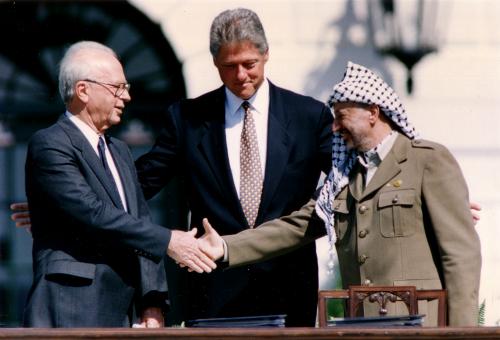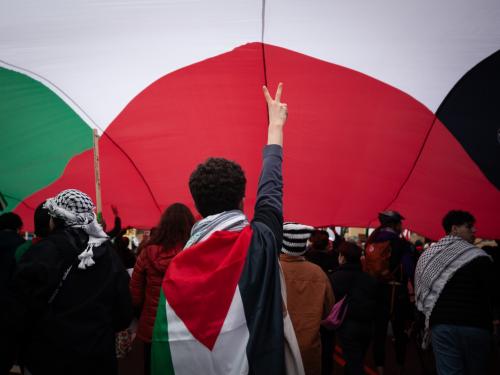The Oslo process—launched 25 years ago today with the famous handshake on the White House lawn between Israeli Prime Minister Yitzhak Rabin and Palestinian leader Yasir Arafat—is officially dead.
Since December 2017, President Donald Trump has made several radical departures from longstanding U.S. policy. The first of which was his decision to recognize Jerusalem as Israel’s capital, thus overturning 7 decades of official U.S. policy and defying a longstanding international consensus. This was followed by dramatic aid cuts to the Palestinian Authority (PA), ostensibly to pressure Palestinian leaders to return to the negotiating table, as well as ending the longstanding U.S. commitment to the United Nations Relief Works Agency for Palestine Refugees (UNRWA), the U.N. agency responsible for providing services to some five million Palestinian refugees. The latter appears to be part of an effort by the administration and its allies on Capitol Hill to strip the vast majority of Palestinian refugees of their refugee status in order to take the issue off the table altogether. The administration’s decision earlier this week to close down the Washington office of the Palestine Liberation Organization (PLO)—the de facto embassy of the Palestinians—removed one of the last tangible vestiges of the Oslo process in Washington.
While it may be tempting to attribute the collapse of the Oslo process to Trump’s highly regressive policies, in reality, the peace process has been in steady decline for well over a decade and had effectively run its course even before the 2016 election. Indeed, the seeds for many of Trump’s actions can be traced to various U.S. laws (here and here) and policies enacted in the mid-1990s—at the height of the Oslo process. While Israeli and Palestinian leaders certainly bear responsibility for the repeated failures of the process, we should not overlook Washington’s role in Oslo’s demise, particularly given its virtual monopoly over the process over the past quarter-century. Below are four points that help explain the failure of the Oslo process and should be borne in mind if and when any new diplomatic process comes about.
1Power matters (a lot)
The dynamic between Israel and the Palestinians is not just a conflict; it is also an occupation. The fact that Israel, which boasts a first-world economy and the most powerful military in the Middle East, rules over the lives of some five million stateless Palestinians in the West Bank and Gaza Strip is a central reality that U.S. policymakers have often overlooked and, in the case of many Trump administration officials, openly denied altogether.
While there is no way to completely level the playing field, an effective mediator must be prepared use its leverage with both parties to advance the goals of the peace process. Since the United States came to dominate the Oslo process in the mid-1990s, however, successive U.S. administrations from both political parties have largely avoided applying pressure on Israel. The rationale behind this was that Israeli leaders would be more willing to “take risks for peace” if they felt politically and militarily secure. Although not every president subscribed to this formula, most have adhered to it, whether out of conviction or simply to avoid running afoul of the powerful pro-Israel lobby and its supporters on Capitol Hill.
The reality has proved to be quite different, however. By relieving pressure on the stronger party, the peace process helped to defray the costs of Israel’s occupation and allowed Israeli leaders to avoid the difficult and politically unpopular decisions that a two-state solution would require. Primarily, the removal of Jewish settlements, transferring territory to Palestinian sovereignty, or dividing Jerusalem.
2Palestinian politics (also) matter
Another misguided notion that has undergirded American mediation efforts over the last couple of decades was the belief that Palestinian politics could be ignored, neutralized, or otherwise subordinated to the perceived needs of the peace process. Indeed, given Washington’s tendency to view the peace process through the lens of the special relationship with Israel, as well as American domestic politics, Oslo became a vehicle not just for resolving the conflict, but for transforming Palestinian politics with the aim of turning them into a suitable peace partner. Unlike its relationship to Israeli domestic politics, the Oslo process was not agnostic toward Palestinian internal politics. In addition to transforming Israeli-Palestinian relations, the Oslo process fundamentally reorganized and redefined Palestinian politics and governing institutions, including their main sources of legitimacy. The highly intrusive nature of the peace process, among other things, meant that the United States, as the chief mediator, donor countries, and even the Israelis, had a direct say—and very often an effective veto—over key aspects of Palestinian political life.
In the end, however, attempts to suppress or reengineer aspects of Palestinian politics failed, and ultimately backfired. The fragmentation, stagnation, and dysfunction that currently characterizes Palestinian politics, while largely self-made, has nonetheless been reinforced by the peace process. In particular, the debilitating schism between Hamas and Fatah, which has paralyzed Palestinian politics, fueled violence and instability in Gaza, and eroded the legitimacy of Mahmoud Abbas’ leadership, was encouraged by the Bush administration and sustained, in part, by Washington’s effective veto over Palestinian reconciliation efforts. In the end, Washington’s heavy reliance on sticks in its dealings with Palestinian leaders succeeded in making them more pliant, but left them too weak to be credible peace partners. By focusing on reassuring Israelis and reforming the Palestinians, rather than on challenging the dynamics that sustained the conflict—namely Israel’s decades-old military occupation of the West Bank and Gaza Strip—U.S. mediation helped to reinforce (if not institutionalize) the vast power imbalance between the two sides while effectively helping to preserve the status quo.
3Mutual accountability is paramount
The points above highlight another cornerstone of effective mediation: mutual accountability. For any process to succeed, the mediator must be willing to call out, and even impose consequences for, actions by both sides that harm the peace process. But while the White House and Congress routinely sanctioned the Palestinians, U.S. officials on both ends of Pennsylvania Avenue have been far less inclined to enact consequences on the Israeli side. Various U.S. administrations have occasionally spoken out on Israeli excesses, for example when it came to settlement construction or the use of excessive force by the Israeli army, but have rarely (if ever) been willing to impose a price.
This was less a function of malice or ignorance than of simple political arithmetic. As the two most powerful actors in the process bound by a “special relationship,” American and Israeli leaders had both the incentive and the ability to shift as much of the political risks and costs onto the Palestinians as possible—especially when things went wrong. The higher the stakes and the potential political costs, the more likely U.S. officials were to deflect those costs onto the Palestinians. This was true when Bill Clinton decided to pin the blame for the failure of the July 2000 Camp David summit and the outbreak of the Al-Aqsa Intifada a few months later solely on Arafat and the Palestinians—even though U.S. officials understood that what was proposed at Camp David fell well short of the Palestinians’ minimal demands and that both sides played a part in the escalating violence. Likewise, while George W. Bush did not approve of the Israeli military offensive in the West Bank throughout the spring of 2002, his alignment with Ariel Sharon following the 9/11 attacks and a wave of terrorist attacks by Palestinian militants gave the Israeli prime minister a relative free hand in his bid to quash the Intifada while systematically destroying Palestinian governing and security institutions along the way.
4The basic ground rules of the peace process must be clear and consistent
As part of the perennial quest to reassure Israel’s leaders, U.S. presidents were often prepared to bend the rules of the diplomatic game in Israel’s favor, even as they held Palestinians to a strict—and ever-evolving—set of obligations. Successive U.S. administrations have upheld U.N. Security Council Resolution 242, which called for ending Israel’s occupation on the basis of “land for peace,” as a pillar of the peace process, even as they simultaneously poked holes in it. Both Clinton and Bush decried Israeli settlements as obstacles to peace, only to carve out major exemptions for East Jerusalem, large “settlement blocs,” “natural growth,” and various other loopholes.
If successive U.S. administrations have spent close to a quarter century trying to fit the square peg in the proverbial round hole, Trump seems content to simply call the square a circle.
Few examples better illustrate the shifting goalposts of the peace process than that of the Road Map, the stillborn peace plan put forward by the United States together with the European Union, United Nations, and Russia in the midst of the Al-Aqsa Intifada. Despite the plan’s explicit emphasis on parallel implementation, the Bush administration conditioned progress on Palestinian statehood on the election of “new leaders” and the enactment of various security and other reforms, while effectively freeing Israel of its own obligations regarding settlements, violence, and incitement. Moreover, neither the end of the Intifada nor the election of Mahmoud Abbas in 2005 following Arafat’s death led to a revival of the diplomatic process.
It was only a matter of time before these contradictions caught up to the process. To his credit, Obama attempted to restore the ground rules of the peace process, rejecting Israeli settlements as illegitimate and reaffirming the sanctity of the 1967 border. Obama’s attempts to hold the line, however, were ultimately stymied by realities on the ground, including Israel’s ever-expanding settlement enterprise, an increasingly weak and dysfunctional Palestinian leadership, and the recalcitrant posture of Israel’s right-wing government and its supporters in Congress. The relative inertia of the Obama years left an opening for the incoming Trump administration, which has been far more blatant in its attempts to re-write the ground rules of the peace process in Israel’s favor. In addition to taking Jerusalem and refugees “off the table,” Trump has avoided explicitly endorsing a two-state solution or an end to Israel’s occupation. If successive U.S. administrations have spent close to a quarter century trying to fit the square peg in the proverbial round hole, Trump seems content to simply call the square a circle.
The demise of the Oslo process leaves a dangerous political and diplomatic vacuum that will be difficult to fill. On the other hand, the removal of what had been a rigid and highly constrictive peace process offers an opportunity to rethink old assumptions, formulas, and possible solutions. The success of any future political process, however, will depend on the extent to which Israeli, Palestinian—and perhaps someday even American officials—internalize the lessons above.







Commentary
Four lessons for the post-Oslo era
September 13, 2018